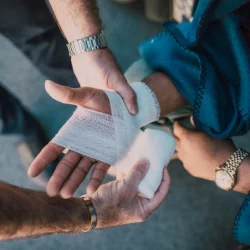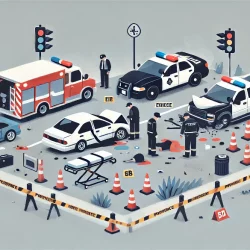Understanding California Car Accident Laws: What You Need to Know
Unfortunately, car crashes are an everyday occurrence in our modern world. Especially in California, highway congestion and high-velocity crashes are seemingly inevitable because many of our communities were planned with daily vehicle travel in mind.
Moreover, car accidents are even more common on the packed, traffic-clogged streets of Los Angeles, Orange County, and the surrounding areas. By being well-versed in California's automobile accident regulations, you should know what to expect if you get into an auto accident in Los Angeles or anywhere in the state of California. While it may help you to understand more about California automobile accident laws, you should still consult an experienced car accident lawyer in Costa Mesa to ensure your rights are protected.
What Are California’s Car Accident Laws?
Generally, California accident regulations influence every facet of a crash and its aftermath. The amount of money you can get for things like lost wages, medical expenses, pain and suffering, and property damage, as well as when and how you can file a claim after a car accident, are all governed by the laws in your state. Drivers involved in an accident in California must have a firm grasp of these regulations and their implications for their case.
First and foremost, drivers in California need to be familiar with our state’s vehicle insurance laws. Auto insurance is mandatory in the state of California. The minimum liability insurance coverage required by California law is 15/30/5, which provides coverage for the following:
- $15,000 for one fatality or injury that requires medical attention.
- $30,000 for multiple injuries or fatalities.
- $5,000 for damage to private property
In the event of a vehicle collision, drivers must always have evidence of insurance on their person. Drivers have to present proof of insurance in the below scenarios:
- When insurance is requested by law enforcement
- If an auto accident occurs involving the insured driver
- When vehicle registrations are being applied for and renewed by drivers
If you are pulled over without evidence of auto insurance, you might face fines or even have your license suspended. What’s more, your auto insurance policy in California must offer underinsured and uninsured motorist bodily injury coverage, as mandated by law. Neither of these coverage options is mandatory for you to purchase, but you must refuse them in writing if you decline them.
Furthermore, if you’ve been involved in an accident resulting in injuries, deaths, or property damage in excess of $1,000, you are required to notify the police, per California law.
How is Fault Determined in a California Car Crash?
When several people might be at fault for an accident, liability is decided by applying a "pure comparative negligence" method. In other words, when an accident occurs in California, all parties deemed to share a portion of the fault must pay for their share of the damages.
Auto accident victims can recoup some of their losses through this rule. In addition, it limits the ability of injured parties to secure the maximum compensation available to them if they were assigned a portion of the fault.
For instance, one driver may have ignored a stop sign while another was speeding. If these two motorists are involved in a car accident, a potential scenario may be that the first is assigned 70% of the fault and the second takes 30%. If calculated damages then total $100,000 from the crash, the injured driver’s reward would be reduced accordingly, and they would get a settlement of $70,000.
Pure Comparative Negligence Laws in California
According to California law, if more than one person is at fault for an auto accident, then they can all be held financially accountable for the resulting damages.
In some places, a victim must have been less than half responsible for the accident in order to get compensation. By contrast, the "pure" part of California’s comparative negligence system allows an accident victim to collect damages, regardless of the degree to which the victim was at fault. Even if the motorist was 90% at fault, they might still seek compensation from the other party for 10% of their losses.
Insurance companies typically dispatch adjusters to comb through paperwork and various documentation when investigating who is at fault for a vehicle collision. Throughout their inquiry, insurance adjusters will review the following:
- Evidence from witnesses
- Reports from law enforcement agencies
- Billing and medical history
- Witness accounts from any involved drivers
You must prove that the other party's careless or negligent actions contributed to or completely caused an accident to win your case in court. Under California law, the first step in doing so is proving that another driver was negligent because they breached a “duty of care” to drive safely and conduct themselves reasonably on the road.
Additionally, keep in mind that you have two years from the date of your accident to file a claim. If you miss the deadline, you may lose your right to seek compensation.
How Do Insurance Companies Cover California Claims?
The time it takes for an insurance company to pay out on a claim might be affected by a number of different variables. After a claim is filed in California, the insurance company has 85 days to seek a settlement. Insurance providers also have deadlines within which they must respond to claims and decide whether or not to pay out a payment:
- The policyholder must receive an acknowledgment of the claim and accompanying documentation and instructions within 15 days. This documentation includes a proof of loss form, which is a sworn statement from the policyholder detailing the full extent of the damages or losses.
- A claim decision is due 40 days after the evidence of loss papers have been submitted.
- The final payment is due 30 days after the claim has been granted.
Of course, there are several variables that might lengthen the time it takes for an insurance company to pay out on a claim, such as under the following conditions:
- If injuries were serious, or there were several parties involved
- Any miscommunication or disagreement among the at-fault driver, the insurance adjuster, and the insurance company
A quick and reasonable resolution to your auto accident claim is your legal right. You can sue the insurer in "bad faith" if you think they're acting illegally or unethically, and if you win, they may have to pay you back the entire amount of your settlement plus fees and interest.
The Role of a California Car Accident Attorney
After suffering injuries in a vehicle crash, victims often face significant obstacles and a myriad of stressful circumstances. But with the help of a skilled California auto accident lawyer who is well-versed in California law, victims can better face the aftermath of a car crash and safeguard their legal rights.
Most importantly, retaining legal representation can greatly maximize the value of your personal injury claim. A seasoned California car accident attorney will act as your representative while communicating with insurers on your behalf.
More to Read:
Previous Posts:




